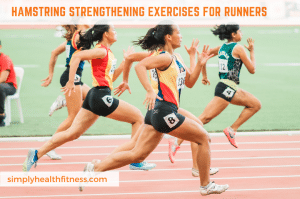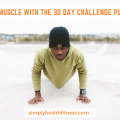Running is fundamentally human.
We evolved to run for long periods of time – and we’re pretty good at it. But only when we are strong and healthy. Running relies on an enormous variety of muscles and none more than the hamstrings. Weak hamstrings expose you to injury risk and hamstrings your running performance. Today, we’re breaking down the best hamstring strengthening exercises for runners and why they’re so important.
Runners Need Stronger Hamstrings
Running involves many muscles – but none more important than the hamstrings.
These large, powerful thigh muscles go through 1000s of stretch-shortening cycles every time you run. They’re key to smooth, powerful strides , but also absorbing the impact of your weight against the floor.
The hamstrings and their tendons are some of the most-used structures when running, so these 2 facts should be no surprise:
- Great runners have great hamstrings
- Running muscle injuries are commonly found in the hamstrings
These tell you why you should train your hamstrings to become stronger: hamstring exercises make you a better runner and keep you running for longer.
The hamstrings are also important for their location – between the knee and hip joints.
These are two of the most important regions in the body, especially for running. They’re common sites of injury and they’re doing a ton of work when you run (along with the ankles). If you’re pounding the trail/pavement/treadmill, these joints need stability.
Weakness leaves both of these joints exposed to the impact and repetition of running.
Strong hamstrings set out better work capacity and joint resilience for running. Meanwhile, weak hamstrings are liable to injury themselves, but also make your knees and hips vulnerable.
The key to sustainable progress is building a strong foundation for your mileage.
What you need
Runners have special needs when it comes to hamstrings and they dictate how you should train.
There are a few key needs to keep in mind:
- Cyclical: running puts a lot of repetitive stress on passive structures – like tendons and other connective tissues. These need to be developed alongside the muscles.
- Asymmetrical: you’re using one leg at a time, which demands strong stabiliser muscles. Training should reflect this with both single- and two-leg exercise.
- Full-range: good running economy uses full range in the hamstring, so it needs to be strong in that full range. Practice long movements under control for better results.
- Postural: good running posture is key. The hamstrings are important in this posture, along with the glutes and core, so working them all together is a great habit to get into.
- Endurance-heavy: exercises should aim for a mixture of strength and muscular-endurance. This means combining more difficult exercises and easier exercises for more reps.
- Stretch-shortening: running moves the hamstring through a stretch-shortening cycle. Using this cycle in your strength training improves performance and health.
Then, you need to remember that the hamstring has two major functions: knee flexion and hip extension.
You need to be strong in both of these motions since running leans heavily on both of them. We’re going to cover both hamstring stretching exercises and the best hamstring strengthening exercises at home – so you can get stronger whatever your setup!
Check out this link for more expert advice on strength and flexibility training.
Hamstring Stretching Exercises for Runners
You need to get stronger in the hamstrings, but good training should also involve general prep. This means including mobility work for a longer, more comfortable hamstring range.
Include these hamstring exercises before your running or strength exercise to reduce injury risk and start building better hamstring control.
Good mobility allows for better strengthening exercise, which builds better long-term mobility. It’s a positive spiral that you can harness for better joint health and sustainable long-term performance.
1. Toe-touch
This is a nice, simple place to start. If you can’t touch your toes with your back flat then you need to work on your hamstring mobility.
Keeping your back flat is key to this hamstring stretch; rounding your spine compensates for bad hamstring flexibility and makes the stretch less effective.
- Take your natural standing position
- Keep your back flat – this is key to the hamstring stretch
- Hinging at the hips, move toward touching your toes
- When you feel the stretch or like you want to round your back, stop for a 1-2 seconds
- Stand back up, hinging at the hips and ‘pulling the back of your hips down’
Don’t mess around at the bottom for too long: get as low as you can, feel the stretch, then stand up.
Repeat 15-30 times for a few sets. If it gets too easy, stand with your feet together, instead.
2. Kneeling hamstring stretch
The kneeling hamstring stretch is a great single-leg stretch that helps you ratchet the stretch up or down. It’s a bit more advanced than the toes touch and gives you more control over the stretch.
- Kneel down on one knee with the other leg straight out in front of yourself
- Set your torso nice and straight, making sure to keep a flat back
- Hinge your hips back, leaning forwards until you feel a stretch in the hamstring
- Hold for a moment before posturing back up
Again, move in and out of the stretch. Get into an end-range position then back off and ease back in. Aim for 10-20 each side per set.
3. Standing toe-touch
This is similar to the normal toe-touch, but now you’re working against gravity. This is a great way of adding more dynamic movement to the hamstring at the hip.
You’re also standing on one leg, and you have to stabilise the hips actively. This makes sure you’re not compensating elsewhere in the movement and helps mobilise the kind of movement you’re training with running or strength exercise.
- Stand straight up with your core active and tight throughout
- Standing on one leg, swing the other leg up to reach the opposite hand
- Try to raise the height of your hand throughout the set as you work through reps
Aim for roughly 10-20 reps for each leg per set.
4. Leg swings
This hamstring exercise is all the movement. It’s a very momentum-heavy movement and can help you get through the positions of the hip and hamstring that you might not get otherwise.
This makes it effective, but also a bit of a fiddly movement if you’re inexperienced. Take your time and add more length/range to this movement as you warm up.
However, when used properly this is a great way to get a ton of movement in the hamstring and hip capsule. Perfect before running and hamstring strengthening exercises.
- Take a grip at a supporting wall or surface around shoulder height to stabilise yourself
- Stand on one leg with your core and glutes tight and active
- Without compromising your torso, swing the other leg forwards as far as possible
- Control the descent, making sure your hips don’t tilt forward at the bottom and squeeze your glutes
Work towards 15-30 reps for either leg. Remember: control on the down-swing is key. Don’t rush reps if you start losing control.
Hamstring Strengthening Exercise for Runners
1. Hamstring Walk-outs
This is a perfect bodyweight hamstring exercise for runners with little strength training experience.
It uses the hamstrings without any loading, and it helps stabilize the hip at the same time. It’s a relatively easy exercise that trains both functions of the hamstring while reinforcing good posture.
You can also use the hamstring walk-out as a primer before running, just don’t over-do it. You don’t want to tire the hamstrings before a long run.
- Set up on the floor your core tight and hips tucked towards the ribcage
- Perform a bridge to get into the starting position
- With your weight in your heels, slowly walk your feet away from your body
- Go as far as is comfortable before reversing the movement and walking your feet back to the starting position
2. Leg curls
The leg curl is a classic for hamstring size and strength. However, you don’t need a gym or curl machine to train this hamstring exercise.
If you can get your hands on a stability ball, sliders, or a laminated surface you’re good to go. These bodyweight leg curl variations are a great way to build stronger, healthier hamstrings.
The sliding movement is also perfect for the stability and active-control it forces you to develop. These have great carryover to running, where knee stability is a key injury-risk factor.
- Lay on the floor in a bridge position with your feet on a slider (or raised on a med-ball)
- Keeping the core tight and hips static, slowly straighten your legs, moving your feet away from your body
- Go as far as you can maintain control and posture, before reversing the movement
- Squeeze your glutes and hamstrings when you return to the starting position – ending the rep
3. Glute bridge
This movement involves the glutes and hamstrings working together. It’s a great way to improve posture and get these key hip-stabilizers working together.
It will pair well with other exercises from this list since it’s all about hip extension and it’s an easy to scale exercise: you can use a single leg version, a deficit, or practice explosive glute bridges.
- Lay on the floor or with your shoulders on a supportive, sturdy surface with your knees at roughly 90-degrees
- Keeping your torso stable and your weight in your heels, slowly lower your hips to the floor
- Lift your hips towards the sky to reverse the movement
- Squeeze your glutes as you return to the starting position, completing the exercise
Read related article: How to Do the Bridge Yoga Pose: A Step by Step Guide
4. Goblet good morning
If you’ve got a med ball or similar weighted implement, good mornings are a powerful development on the normal toe-touch.
They train the upper back, core, glutes, and hamstrings in one movement. This is perfect for running posture as well as hamstring strength. It also develops strength in the end-ranges of your hamstrings, building both mobility and strength.
This is why we love the front-loaded good morning so much: it builds so many great qualities with one exercise. If you can get your hands on any kind of weighted implement, it’s perfect.
- Take a comfortable standing position with your feet at hip-width and a med-ball (or other implement) hugged tight to your chest
- Keeping your back flat and your torso in the same position, hinge at the hips and slowly lower yourself like in a toe-touch
- Continue until you feel a stretch in the hamstrings or the limits of your torso posture
- Reverse the movement by contracting the hamstrings and glutes together – pushing the hips forward and standing up straight
You can also stop just short of standing up straight when you’re more experienced to chain reps together. To start with, practice the reps slowly and finish with a squeeze as you stand up tall.
5. Single-leg stiff-leg deadlift
Again, like the good morning, you can develop serious hamstring control with as little as a med-ball.
The single leg stiff-leg deadlift is more than a hamstring strengthening exercise
It builds hamstring strength and control, hip control, better rotational core strength, and overall body-awareness. It’s about the best movement you can use for building up running muscle and control.
- Stand up straight at hip width with a med ball or other light object on the floor in front of you
- Taking a single leg stance, keep your hips square and your core tight, making sure not to bend the knee
- Hinge at the hips, keeping your back leg straight, and reach down to grab the ball
- Pause briefly with your hands on the ball, focusing on stability and core/glute tightness
- Reverse the movement, standing up straight without moving the knee, squeeze your glutes at the top
- Return the ball to the floor – slowly and controlled – to complete one repetition
6. Nordic curl
This is a brutal exercise that develops amazing hamstring strength.
It’s basically a bodyweight curl but it uses your whole bodyweight, unlike the med ball or slider hamstring curls above.
Nordic curls are a challenging exercise but offer amazing hamstring development.
- Set up with your feet hooked under a heavy, stable surface or supporting bar and your knees on a towel or other soft surface
- Keep your torso and glutes tight, so your knees and head are in a straight line
- Lower yourself to the floor as slowly as possible by extending the knee
- Catch your weight in a push-up position
- Use your upper body to push off the floor and use the momentum and your hamstrings to return to the upright starting position, completing the rep.
If you can’t complete the movement with the extra momentum, then just focus on lowering yourself as slowly as possible.
A simple hamstring workout for beginners
So when we put it all together, what does a simple runner’s hamstring workout look like?
Warm-up
- 20 toe-touches x 2 sets
- 10 standing toe-touches x 2 sets
- 15 leg swings x 2 sets
Hamstring strengthening exercises
- 6-10 assisted Nordic curls (or Nordic curl lowers) x 3 sets
- single-leg med-ball SLDLs to technical failure x 3 sets
- 20 goblet good mornings x 2 sets
- 20 glute bridges x 2 sets
- towel leg curls to failure x 4 sets
Cool-down
- 15 toe-touches x 2 sets
- 10 kneeling hamstring stretches x 2 sets
Final Thoughts
Running is a sport and exercise that prizes good preparation and good technique.
Proper strength and conditioning is the difference between a casual and a runner who improves rapidly. You need to put as much time into developing your body as you do into your technique or mileage plan.
It’s fun to lace up the shoes and put in the miles, but you need to make sure you’ve set the foundation for those miles. Improving your hamstring strength helps you with both, for longer, and with less annoying pains along the way!




